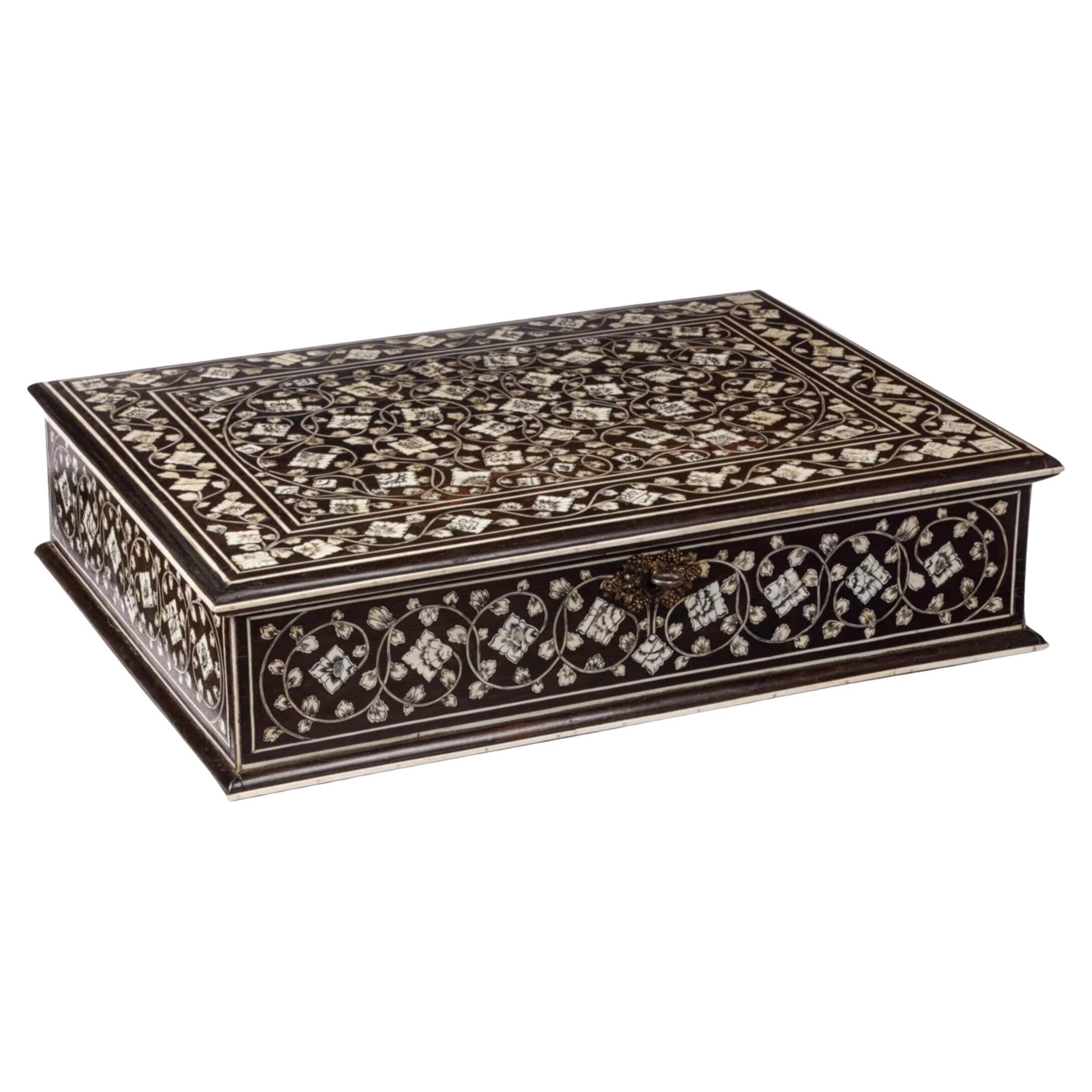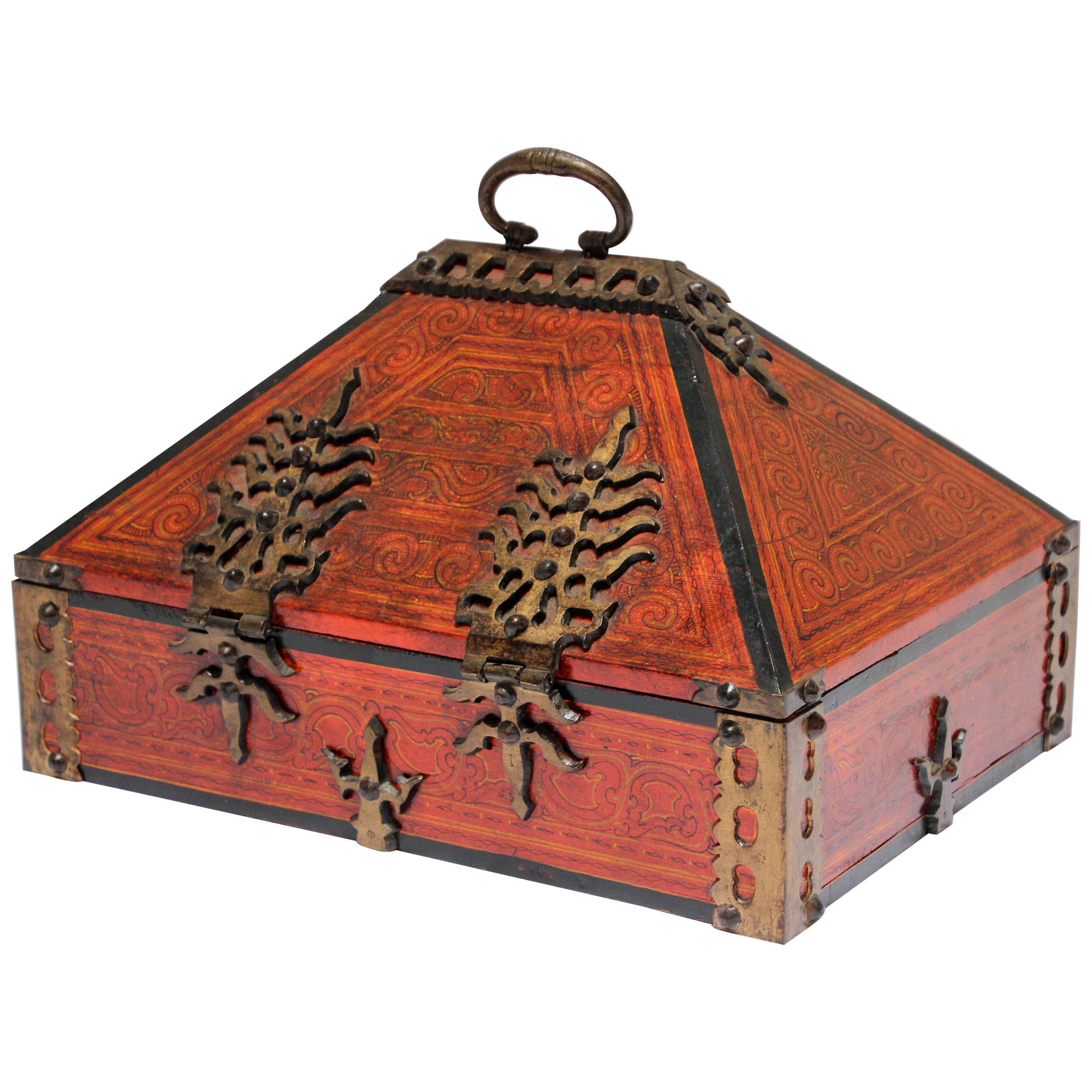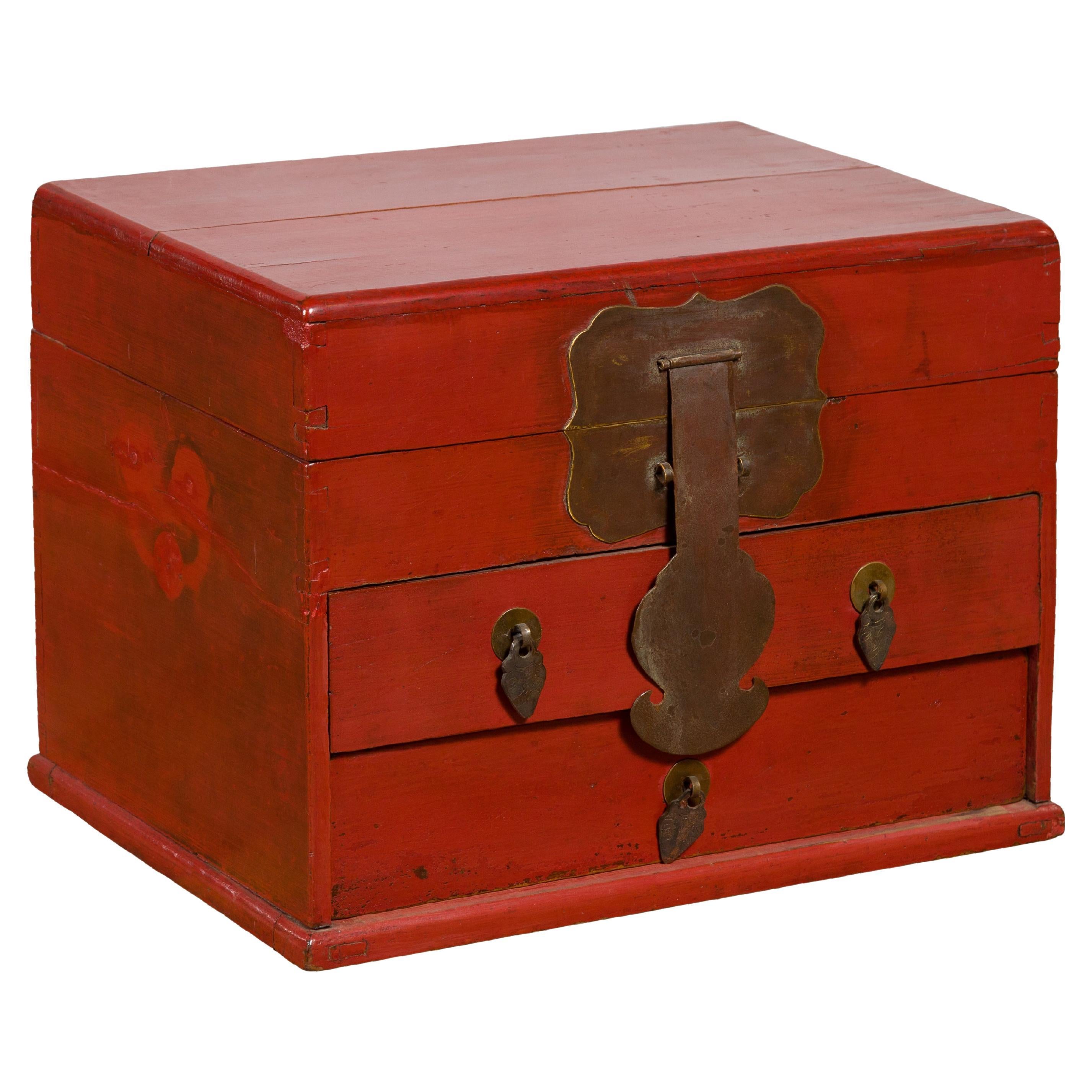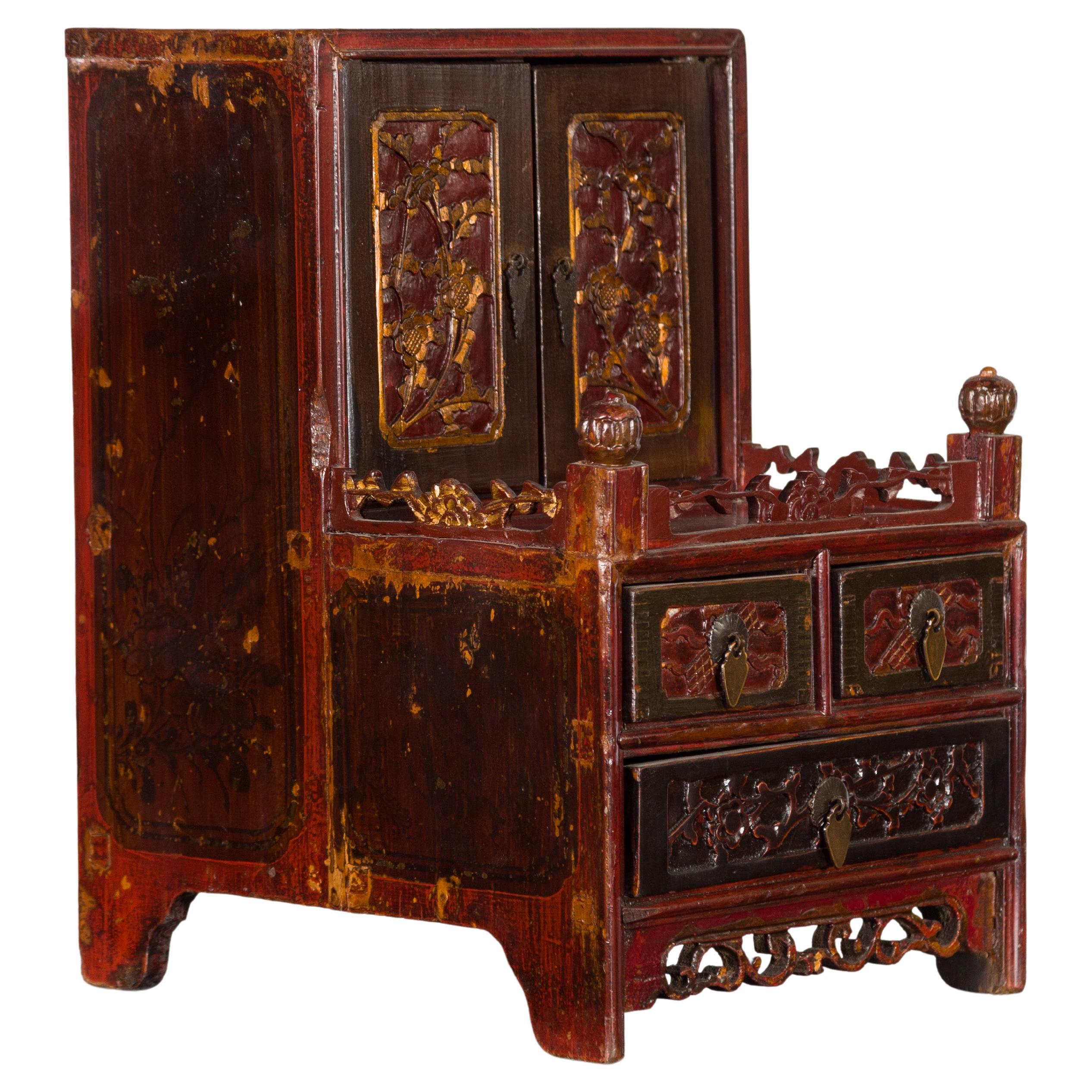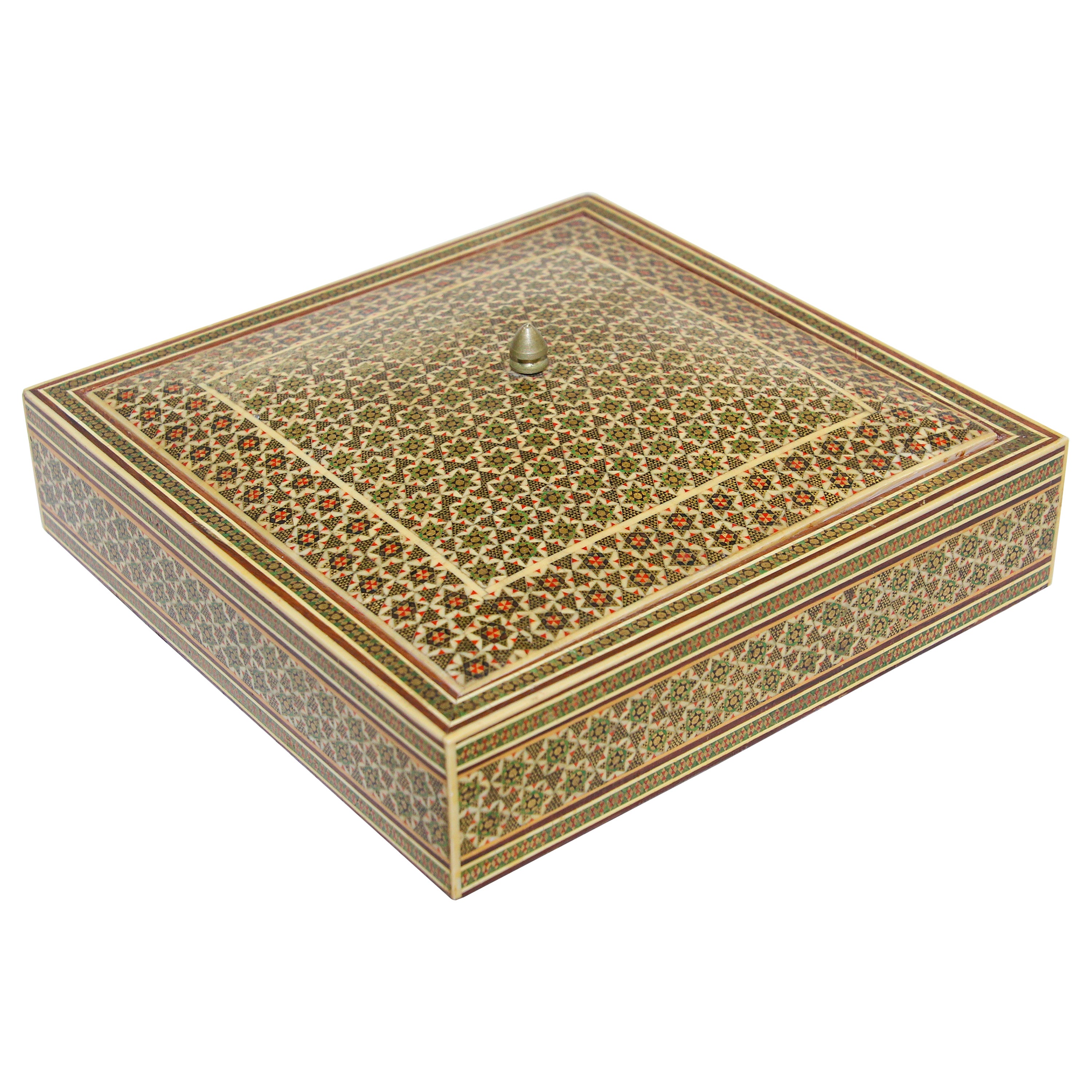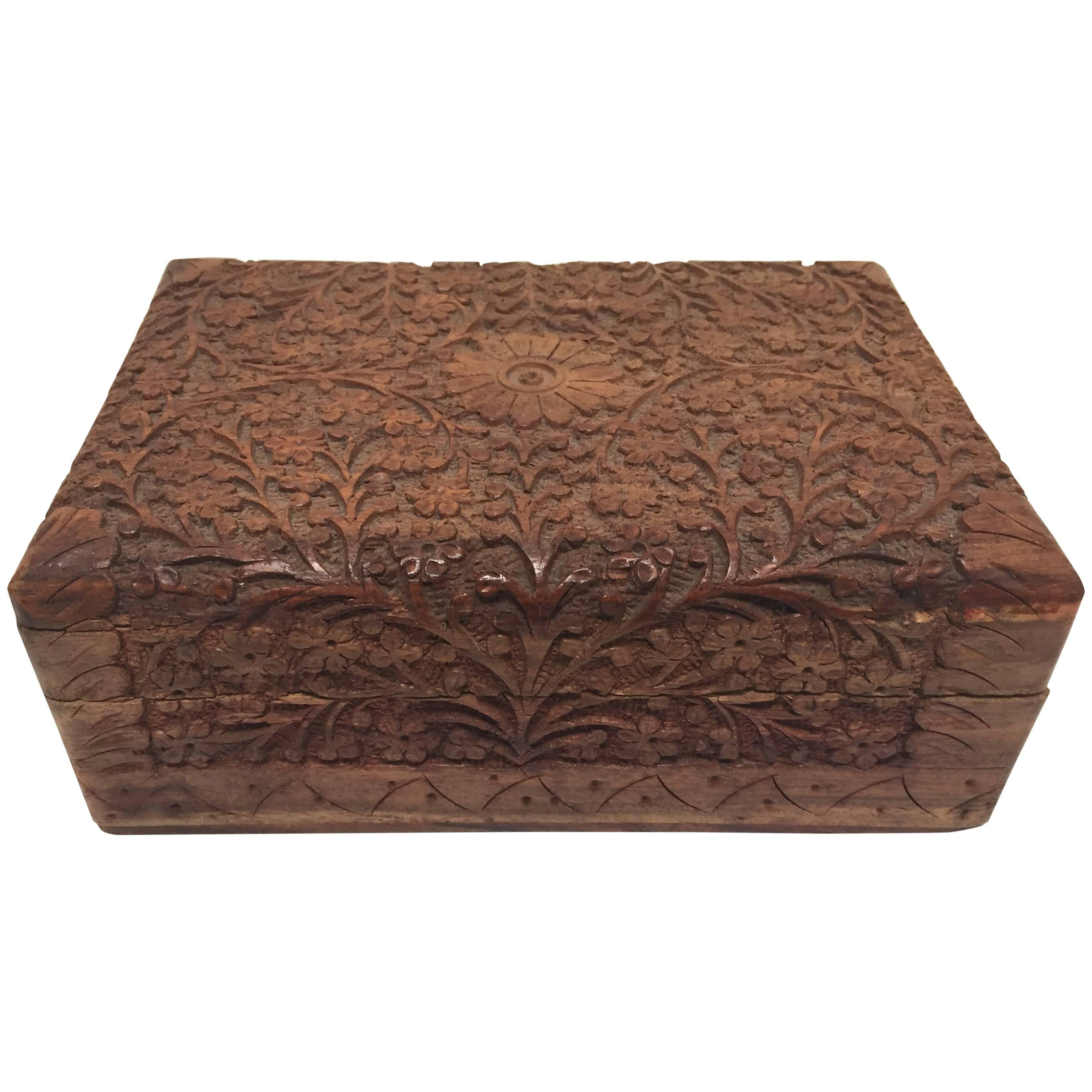Items Similar to Colonial Islamic Arabian Market Jewelry Box, 18th Century, India/Malabar Coast
Want more images or videos?
Request additional images or videos from the seller
1 of 3
Colonial Islamic Arabian Market Jewelry Box, 18th Century, India/Malabar Coast
About the Item
AN INDIAN ROSEWOOD AND EBONY BRASS MOUNTED BOX FOR THE ISLAMIC MARKET
Malabar Coast, 18th century
With a large drawer with several compartments under a lid with two compartment interior, with brass mounts and chased brass decoration, including a key.
L. 26.4 x W. 19.5 x H. 12.3 cm
Note:
This type of box is usually described as a cash box but probably could be anything from a writing box to a jewellery box. It was not made primarily for the European market but rather for the Arabian and Persian markets.
- Dimensions:Height: 4.85 in (12.3 cm)Width: 10.4 in (26.4 cm)Depth: 7.68 in (19.5 cm)
- Style:Islamic (Of the Period)
- Materials and Techniques:
- Place of Origin:
- Period:
- Date of Manufacture:1700-1780
- Condition:Wear consistent with age and use.
- Seller Location:Amsterdam, NL
- Reference Number:1stDibs: LU5458220974672
About the Seller
5.0
Vetted Seller
These experienced sellers undergo a comprehensive evaluation by our team of in-house experts.
Established in 1985
1stDibs seller since 2020
19 sales on 1stDibs
Typical response time: 3 hours
- ShippingRetrieving quote...Ships From: Amsterdam, Netherlands
- Return PolicyA return for this item may be initiated within 7 days of delivery.
More From This SellerView All
- 18th century Dutch-Colonial ‘Vizagapatam’ pen-engraved bone inlaid ebony boxLocated in Amsterdam, NLA large Indian Colonial ‘Vizagapatam’ pen-engraved bone inlaid ebony box Masulipatnam or Vizagapatam, 2nd half 18th century H. 10.8 x W. 47 x D. 34 cm ...Category
Antique Late 18th Century Indian Dutch Colonial More Asian Art, Objects ...
MaterialsBone, Ebony
- 16th-Century Indo-Portuguese Colonial Mother-of-pearl Gujarat CasketLocated in Amsterdam, NLAn exceptional Indo-Portuguese colonial mother-of-pearl veneered casket with silver mounts India, Gujarat, 2nd half of the 16th century, the silver mounts Goa or probably Lisbon Measures: H. 16 x W. 24.6 x D. 16.1 cm An exceptional Gujarati casket with a rectangular box and truncated pyramidal lid (with slopes on each side and a flat top) made from exotic wood, probably teak (Tectona grandis), covered with a mother-of-pearl mosaic. The tesserae, cut from the shell of the green turban sea snail (Turbo marmoratus, a marine gastropod) in the shape of fish scales, are pinned to the wooden structure with silver ball-headed nails. The casket is set on bracket feet on the corners. The masterfully engraved decoration of the silver mounts follows the most refined and erudite Mannerist repertoire of rinceaux and ferroneries dating from the mid-16th century. The high quality and refinement of the silver mounts and, likewise, the silver nails that replaced the original brass pins used to hold the mother-of-pearl tesserae in place indicate the work of a silversmith probably working in Lisbon in the second half of the 16th century. The Indian origin of this production, namely from Cambay (Khambhat) and Surat in the present state of Gujarat in north India, is, as for the last three decades, consensual and fully demonstrated, not only by documentary and literary evidence - such as descriptions, travelogues and contemporary archival documentation - but also by the survival in situ of 16th-century wooden structures covered in mother-of-pearl tesserae. A fine example is a canopy decorating the tomb (dargah) of the Sufi saint, Sheik Salim Chisti (1478-1572) in Fatehpur Sikri in Agra district in the state of Uttar Pradesh, north India. This is an artistic production, geometric in character and Islamic in nature, where usually the mother-of-pearl tesserae form complex designs of fish scales or, similar to the dishes also made using the same technique, with the thin brass sheets and pins, stylized lotus flowers. The truncated pyramidal shape corresponds, like their contemporary tortoiseshell counterparts also made in Gujarat, to a piece of furniture used in the Indian subcontinent within the Islamic world prior to the arrival of the first Portuguese. This shape, in fact, is very old and peculiar to East-Asian caskets, chests or boxes used to contain and protect Buddhist texts, the sutras. A similar chest is the famous and large reliquary chest from Lisbon cathedral that once contained the relics of the city's patron saint, Saint Vincent. Both match in shape, having the same kind of socle or pedestal and bracket feet, and in their engraved silver mountings, featuring the same type of refined, erudite decoration. Their differences lie in the silver borders that frame the entire length of the edges of the chest (both the box and the lid), pinned with silver nails, and on the lock plate, shaped like a coat of arms in the Lisbon example. Given the exceptional dimensions of the reliquary casket...Category
Antique 16th Century Indian Jewelry Boxes
MaterialsSilver
- 17th century colonial Sinhalese ebony two-door cabinet with silver mountsLocated in Amsterdam, NLA splendid Dutch-colonial Sinhalese ebony two-door cabinet with silver mounts Sri Lanka, Kandy, 2nd half 17th century, the mounts later The cabinet with a central drawer with hidde...Category
Antique 17th Century Sri Lankan Dutch Colonial Jewelry Boxes
MaterialsSilver
- Splendid Indo-Portuguese Colonial Sculpture of Nagini from Goa, 17th CenturyLocated in Amsterdam, NLA fine Indo-Portuguese inlaid teak wood figure of Nagini India, Goa, 17th century Measure: H. 55 cm (with stand, and with ring for wall hanging) The sculpture can be perceived as such but probably is one of four legs of an Indo-Portuguese contador...Category
Antique 17th Century Indian Jewelry Boxes
MaterialsEbony, Teak
- 18th-century Dutch-colonial Peranakan mother-of-pearl casket with silver mountsLocated in Amsterdam, NLAn Indonesian Peranakan mother-of-pearl inlaid mastic sirih casket with silver mounts Jakarta (Batavia), circa 1720-1730, the silver hinges marked for Batavia, maker’s mark HS or SH...Category
Antique Mid-18th Century Indonesian Dutch Colonial Antiquities
MaterialsSilver
- Dutch Walnut Writing Box with Brass Mounts, Early 18th CenturyLocated in Amsterdam, NLA Dutch walnut writing box with brass mounts Early 18th century Measures: H. 20 x W. 47 x D. 28 cm The interior is divided in various compartments for an inkpot, sand dispen...Category
Antique Early 18th Century Dutch Desk Sets
MaterialsBrass
You May Also Like
- Large Jewelry Dowry Box Lacquered Teak and Brass India 1900By RajhastaniLocated in North Hollywood, CALarge Teak Jewelry Dowry Box with Brass, Late 19th Century, India. Indian Dowry Box in Lacquered Teak with Decorative Brass. This large Ethnic Indian ...Category
Mid-20th Century Indian Agra Decorative Boxes
MaterialsBrass
- Chinese Early 20th Century Red Lacquer Jewelry Box with Bronze HardwareLocated in Yonkers, NYA Chinese red lacquered jewelry box from the early 20th century, with lidded top and three drawers. Created in China during the early years of ...Category
Early 20th Century Chinese Jewelry Boxes
MaterialsMetal, Bronze
- Qing Dynasty 19th Century Red and Brown Lacquer Jewelry Box with Carved FoliageLocated in Yonkers, NYAn antique Chinese Qing Dynasty red and dark brown lacquer elmwood jewelry box from the 19th century with carved and gilt motifs. Created in China during the Qing Dynasty era, this j...Category
Antique 19th Century Chinese Qing Jewelry Boxes
MaterialsWood
- Moorish Micro Mosaic Inlaid Jewelry BoxBy RajhastaniLocated in North Hollywood, CAMoorish style micro mosaic marquetry inlaid jewelry box with lid. Intricate inlaid Anglo Indian box with floral and geometric Islamic Moorish mosaic Sadeli design in a square shape form with mosaic inlay and marquetry, very fine artwork, lined in red velvet. Museum collector piece like the one in Doris Duke Islamic Art Museum. The repeating geometric patterns of Sadeli Mosaic are what give it beauty and richness. This decorative technique is a type of micro mosaic featuring repeating geometric patterns. A highly skilled craft, it has had a long history in India and the Middle East with early examples dating back to the 16th century. In the 1800s, it became popular as a decoration on a variety of boxes, card cases, and chess boards imported from India. Since Bombay became a center of making them, they became known as Bombay boxes...Category
Mid-20th Century Indian Agra Jewelry Boxes
MaterialsWood
- Anglo Raj Hand-Carved Decorative Jewelry BoxBy RajhastaniLocated in North Hollywood, CAHand-carved Anglo Raj early 20th century carved wood box richly decorated overall with arabesques and floral carving. Hinged lid shallow relief carving with interior lined with red r...Category
Early 20th Century Indian Anglo Raj Decorative Boxes
MaterialsSandalwood
- 19th Century Asian Wooden Decorative Storage BoxLocated in Germantown, MDMid 19th Century Asian Wooden decorative storage box with lid. Measures 13.5"W x 11"D x 11.5"H.Category
Antique Mid-19th Century Chinese Chinese Export Decorative Boxes
MaterialsMetal
Recently Viewed
View AllMore Ways To Browse
Market Furniture
India Jewlery
India Jewelry
Jewellery India
Jewelry Of India
Jewelry Box Large
Large Jewlery Box
Large Jewlry Boxes
Large Jewellery Box
Large Jewelry Boxes
Antique Furniture Market
Market For Antique Furniture
Islam Furniture
India Brass
L Jewelry Box
18th Century Jewlery Box
Writing Box
Antique Islam
